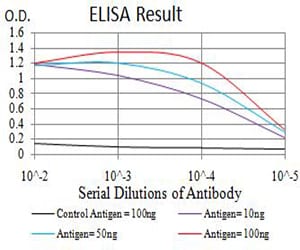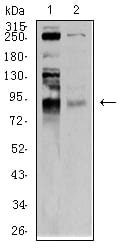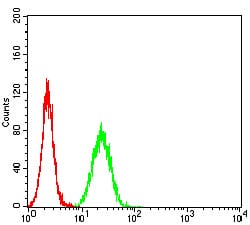


| WB | 咨询技术 | Human,Mouse,Rat |
| IF | 咨询技术 | Human,Mouse,Rat |
| IHC | 咨询技术 | Human,Mouse,Rat |
| ICC | 技术咨询 | Human,Mouse,Rat |
| FCM | 1/200 - 1/400 | Human,Mouse,Rat |
| Elisa | 1/10000 | Human,Mouse,Rat |
| Aliases | FSH; NAT; RNF3; FSRG1; RING3; D6S113E; O27.1.1 |
| Entrez GeneID | 6046 |
| clone | 7C1B10 |
| WB Predicted band size | 88kDa |
| Host/Isotype | Mouse IgG2b |
| Antibody Type | Primary antibody |
| Storage | Store at 4°C short term. Aliquot and store at -20°C long term. Avoid freeze/thaw cycles. |
| Species Reactivity | Human,Rat |
| Immunogen | Purified recombinant fragment of human BRD2 (AA: 227-364) expressed in E. Coli. |
| Formulation | Purified antibody in PBS with 0.05% sodium azide |
+ +
以下是关于BRD2抗体的3篇参考文献的简要概括:
1. **文献名称**:*Brd2 is required for murine neural stem cell maintenance and gliogenesis*
**作者**:Shang, E., et al.
**摘要**:该研究利用Brd2抗体检测小鼠神经干细胞中BRD2蛋白的表达,发现Brd2通过调控细胞周期相关基因维持神经干细胞的自我更新能力,并参与胶质细胞分化过程。
2. **文献名称**:*BET bromodomain inhibition suppresses graft-versus-host disease after allogeneic bone marrow transplantation*
**作者**:Wu, T., et al.
**摘要**:研究使用BRD2抗体验证其在T细胞中的表达,发现抑制BRD2可减少促炎因子释放,减轻骨髓移植后的移植物抗宿主病(GVHD),提示其作为治疗靶点的潜力。
3. **文献名称**:*Brd2/4 and Myc regulate alternative cell lineage programs during early osteoclast differentiation in vitro*
**作者**:Lamoureux, F., et al.
**摘要**:通过Brd2抗体进行染色质免疫沉淀(ChIP),揭示了BRD2与Myc协同调控破骨细胞分化的分子机制,为骨代谢疾病提供了新的研究方向。
这些文献均通过BRD2抗体探究其在细胞分化、免疫反应及疾病中的作用,涵盖基础机制与潜在治疗应用。如需具体DOI或期刊信息,可进一步补充关键词或年份筛选。
The BRD2 antibody is a crucial tool for studying the Bromodomain-containing protein 2 (BRD2), a member of the BET (bromodomain and extraterminal domain) family. BRD2 plays a pivotal role in epigenetic regulation by binding to acetylated lysine residues on histones via its tandem bromodomains, facilitating transcriptional activation or repression. It is involved in critical cellular processes, including cell cycle progression, chromatin remodeling, and immune response regulation. Dysregulation of BRD2 has been linked to cancers, neurological disorders, and inflammatory diseases, making it a therapeutic target of interest.
BRD2 antibodies are widely used in research to detect protein expression, localization, and interactions through techniques like Western blotting, immunofluorescence, immunohistochemistry, and chromatin immunoprecipitation (ChIP). These antibodies help elucidate BRD2's role in gene regulation, particularly its association with transcriptional elongation factors and mediators of oncogenic pathways (e.g., MYC). Commercially available BRD2 antibodies vary in specificity, with common hosts including rabbit and mouse. Researchers must validate antibodies using knockout controls or siRNA to ensure target specificity, as cross-reactivity with other BET family members (e.g., BRD3. BRD4) can occur. Applications extend to drug discovery, especially in evaluating BET inhibitors for cancer therapy. Proper experimental optimization, such as adjusting antibody dilution and fixation methods, is essential for reliable results.
×